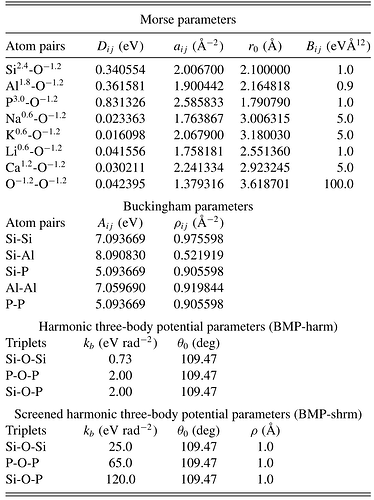Dear,
I would like to implement the improved Pedone potential in LAMMPS (https://doi.org/10.1103/PhysRevMaterials.5.045602), referred to in the literature as BMP. I am currently using the original potential, referred to in the literature as PMMCS (https://doi.org/10.1021/jp0611018), which I have implemented without problems since the LAMMPS release of April 17, 2024. The enhanced potential contains the parameters for the Pedone potential for binary oxides, the Buckingham potential for interactions between identical atoms, and also includes terms related to the Harmonic three-body potential parameters (BMP-harm) and Screened harmonic three-body potential parameters (BMP-shrm).
For PMMCS, I’m using something like
pair_style hybrid/overlay pedone 15 coul/long 15
pair_coeff * * coul/long
# Dᵢⱼ(kcal/mol) aᵢⱼ (Å⁻²) r₀ (Å) Cᵢⱼ (kcal/mol Ź²)
pair_coeff 1 2 pedone 7.853359 2.006700 2.100000 23.060540 # Si–O
pair_coeff 2 2 pedone 0.977652 1.379316 3.618701 507.331880 # O–O
The specific question is how do I complement the interatomic potential file to include the rest of the interactions? In the attached photo is the table with the parameters of the potential I would like to implement. Thanks.
